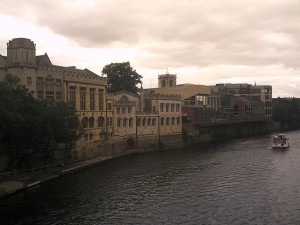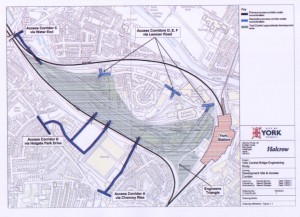Labour’s plans to spend £9.2 million creating a “Digital Media Centre” (DMC) at the York Guildhall will be up for review on 19th January

York Guildhall
The Guildhall has been largely unused for 2 years.
The Council first proposed to fund a DMC in July 2012 when “only” £1.4 million was earmarked for a partnership project. The figure has “grown like topsy” since then. The preferred site in 2012 was the Bonding Warehouse.
Labour have been pouring money into the scheme since the summer of 2013 – when they still enjoyed an overall majority on the Council. They failed to secure broad backing for their plans and a bid for Lottery Funding subsequently failed.
A hastily convened Cabinet meeting on 16th December 2014 agreed to spend another £500,000 on design work plus financial, procurement and legal support.
Up to £100,000 is also to be spent on interim repairs to the Guildhall as it is clear that any new DMC use could not be operational for at least 3 years.
The argument for providing space for digital industries (which are a modest, but expanding, part of the local economy) is that the private sector will not fund offices where there is no guarantee of long term use. Some digital companies expand and contract the amount of space that they use on a regular basis.
Lack of a stable rental income is also the reason why the Council should not plunge further into debt to subsidise what would be a high risk venture.
It was presumably also the reason why no revenue budget for the DMC was published with the Council committee papers in December. “Don’t know” is a poor basis on which to make an investment decision.
The original reports, which sought to forecast demand for this type of casual use, are out of date (DMZ report 2011 for Science City). There is a lot of office space available in the City not least that associated with Higher Education facilities. The workshops, established by the private sector, in partnership with the last Council, at Clifton Moor, often have vacant spaces.
So what now?
The Council should not throw good money after bad. It needs to pause and ensure that other options are fully explored.
The Guildhall complex could be offered on the open market to see what interest is generated. It is a prime site and could accommodate a range of shopping, hotel and office uses.
The historic (listed) Guildhall itself must be properly conserved and accessible to the public. While this might inhibit some potential uses the approach can be similar to that which has seen the Assembly Rooms, De Grey Rooms and (most recently) the Theatre Royal building being successfully taken over by a local conservation charity.
Such an approach would not rule out small office space being provided which is suitable for digital media arts use but the risk, and cost, to Council taxpayers would be reduced.
It is only when these avenues have been explored that the Council will know what viable options are available and an informed choice can then be made.
—————–
It is unfortunate that, at a time when the DMC issue is coming to a head, the Councils involvement in the successful bid to become a UNESCO City of Media Arts is coming into question.
The problems arise from an apparent lack of candor about the amount that the bid, and the subsequent programme of activities, will cost taxpayers. Freedom of information requests have revealed some surprisingly high consultancy fees and opaque appointment processes while two years ago the cost of trips to south east Asia had raised eyebrows.
Time for some public accountability on this issue we think.


